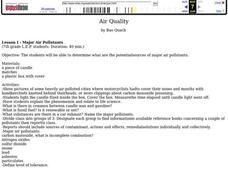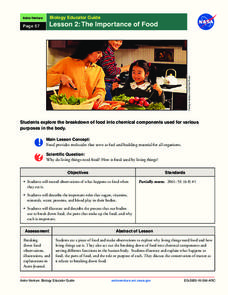Curated OER
Home Inspection/Interview Regarding Lead Poisoning
For this home inspection and lead poisoning worksheet, students read 3 different scenarios about family homes and their children with noticeable amounts of lead in their blood. Students identify the risk factors in each scenario and...
Curated OER
Lead Poisoning and Environmental Health
Students explore issues surrounding lead poisoning. They investigate how and why government agencies and laws were established to protect the public. Students examine the national EPA Elimination Plan. Students design a campaign to...
Curated OER
The Deadly Frogs of Manu
Students investigate the poisonous frogs of Manu, Peru. They watch and discuss a video, conduct Internet research on poison frogs, accurately color downloaded template models of the frogs of Manu, and create a poster using the colored...
University of Notre Dame
Safe Science Lab Safety Awareness
Prepare young scientists for the ins and outs of lab safety with a thorough list of symbols, icons, and rules about staying safe during experiments. Additionally, the resource provides several assessment pages for kids to reflect on what...
Curated OER
Protect Yourself
Students read about the marketing of permethrin-treated clothing to help prevent insect borne illnesses. They design a poster to create awareness of an insect, animal or plant species which is harmful to humans.
National Center for Case Study Teaching in Science
Bad Fish, Bad Bird
In an advanced biology lesson, learners see a PowerPoint about biologist Dr. Westwood, a two-time victim of poisoning. Designed to be used with clickers in the classroom, you could modify the lesson by creating a worksheet from the...
Curated OER
Air Quality Issues
Students identify the different layers of the atmosphere. They examine the different types of air pollutants. They also discover laws in effect that work to protect the environment.
Curated OER
Chemicals, Chemicals, Everywhere
Students divide substances into categories: made of chemicals/not made of chemicals, synthetic/naturally occurring, and toxic/nontoxic. They observe a mystery chemical and determine what precautions they need to take when handling an...
Curated OER
Biological Diversity and Conservation
In this conservation biology activity, students will complete 9 short answer questions on the different strategies of conservation biology, including the Endangered Species Act and establishing protected areas for animals.
Curated OER
Specialized Structures and Environment
Fifth graders read about how different animals protect themselves, and how characteristics give animals an advantage in their environment. Students then discuss a variety of "outer" wear for humans, and what they might choose to wear in...
Curated OER
Air Quality
Students determine potential sources of major air pollutants, explain how acid rain is generated and how it affects the environment, discuss global warming, and explore protective role of ozone and cause of ozone layer thinning. Lessons...
Curated OER
Oil Spill Dangers
Students analyze the effects of oil spills on our environment and develop action plans to protect animals and habitats.
Curated OER
Environmental Hazards
Pupils identify environmental hazards on a simulated field trip. They analyze the exposure and suggest methods to eliminate or reduce exposure to toxic sources.
NASA
Biology Training Module
Are you a koalafied biologist? The lesson begins with research about human survival and our ecosystem. Then, an online training module simulates the effects of changes to the plants and animals in an ecosystem. Finally, scholars research...
NASA
The Importance of Food
Pupils make observations while eating food. They act out the process of food breaking down in the body and the roles of various chemical components, such as sugar and protein. It concludes with an activity illustrating the process and a...
American Museum of Natural History
What's This? Staying Safe
Amaze the class with the creative adaptations species employ to trick predators. An online interactive lesson introduces learners to six different species with unique adaptations. Each species highlights a different adaptation and its...
US National Library of Medicine
Science and Society: Preventing the Spread of Disease
Looking for a valuable resource on the spread of infectious diseases? Here is a lesson in which pupils simulate the spread of diseases and learn about how to prevent them from spreading. Class members read case studies about diseases,...
Cornell University
Weed IPM
Go on a weed hunt! Scholars gain insight into the characteristics of plants and examine the outdoor environment in order to identify five different types of weeds. Learners then show what they know with a one-page reflection.
Biology Junction
Viruses, Viroids, and Prions
Are viruses living or non-living? According to the presentation, they are both and neither. Clearly, this requires clarification and an in-depth look at viruses, viroids, and prions. Young scientists learn about the history, structure,...
Learning Games Lab
Nitrogen in Pollutants
Responsible farming is important for maintaining natural resources. Eager scientists complete a WebQuest to explore what happens to nitrogen when it enters the soil. They learn about the chemical makeup of nitrogen-based molecules and...
American Museum of Natural History
Finding Fossils
How does one go about finding fossils? Find out with an informative webpage that looks at the digging process, showcases rocks and common fossils, helpful tips, and a list of archeological do's and don'ts.
Curated OER
Prairie Predator and Prey
Fifth graders brainstorm a list of animals that live on the prairie, and classify them as predators and prey. They conduct interviews where they ask the animals what they need to look out for to sustain life on the prairie.
Curated OER
Basics of Science
In this basics of science instructional activity, students review the metric system, the difference between homogenous and heterogenous mixtures, the scientific method, and science lab first aid. This instructional activity has 15 short...
Curated OER
Defining Hazardous Waste
Students examine the relationship between hazardous substances and hazardous waste. They identify toxic chemicals and how they are disposed of. They work together to answer questions about how they are improperly used.

























